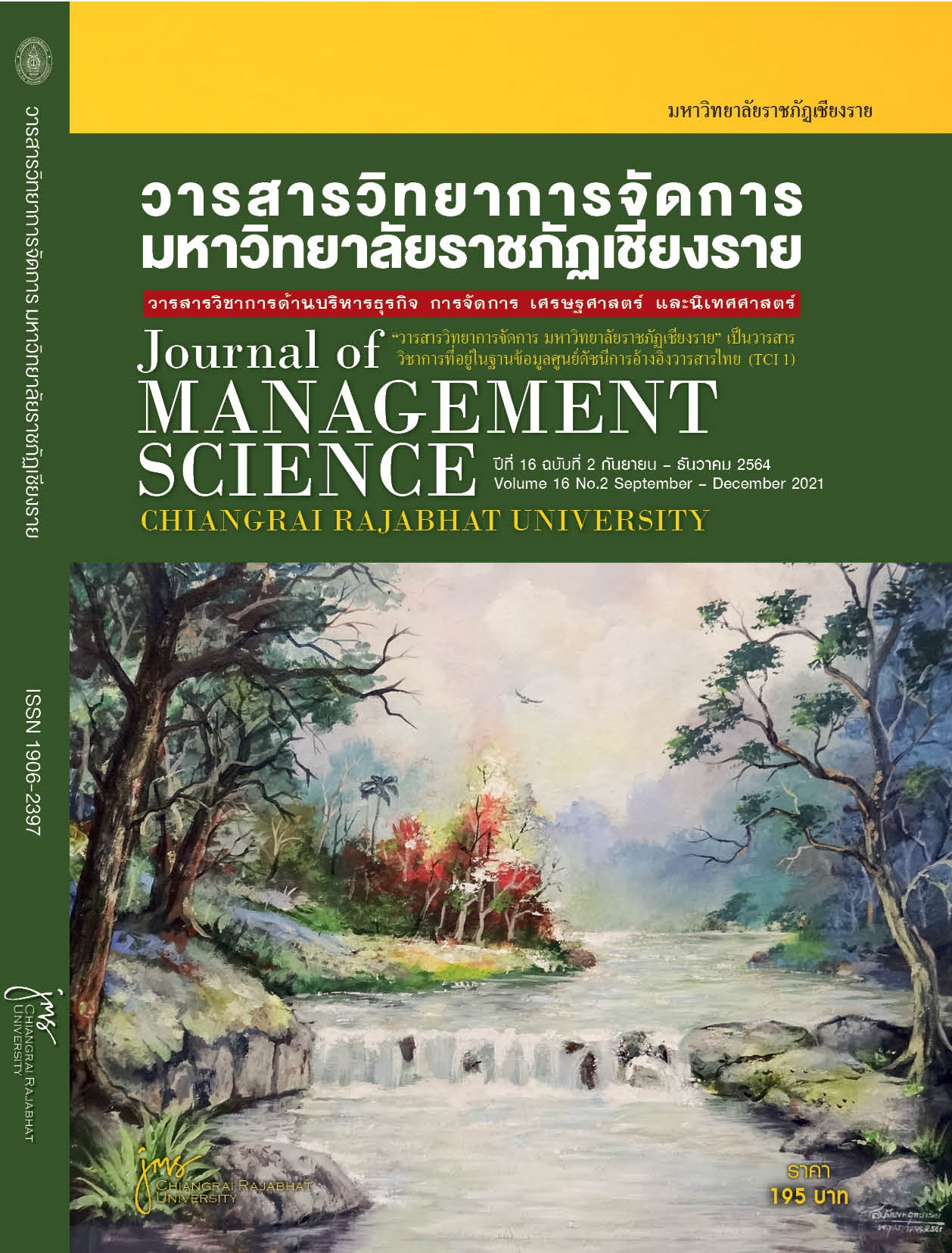The Potential Development of Creative Tourism Using Integrative Business Model: a Case Study of Khunchaitong Village, Surin Province
Main Article Content
Abstract
This research aims to study the pattern, operational context, problems and obstacles of Khunchaitong village tourism, as well as analyze components in the integrative business model, and develop the integrative business model for enhancing the potential of Khunchaitong’s creative tourism in Surin province. This research employed a qualitative method using a semi-structured interview and a focus group technique to collect data from homestay tourism entrepreneurs and tourism’s stakeholders of Khunchaitong tourism. The results presented that Khunchaitong tourism began with the aim to solve the problem of elephant begging on the streets, and received support from the Save Elephant Foundation, Chiangmai province to operate the tourism. The tourism operation has started since December 1, 2016, and organized by the community homestay entrepreneur group. The community provides tourists with experiences to participate and learn the way of local preserved elephants, local cultures, volunteer activities, and natural tourism attractions. The problems of Khunchaitong tourism consist of 1) the potential of members and group in English communication with tourists, conflicts of members in different opinions, lack of knowledge in tourism program and souvenir design, and the use of information technology 2) the cleanliness of the village and the lights at night 3) the lack of marketing on domestic tourists, and 4) the lack of supports from external organizations. The analysis of the business model components was based on the business model canvas concept. Opinions from tourism entrepreneurs and stakeholders were integrated in order to develop the integrative business models that cover components, including customer segment, value proposition, channels, business alliances, customer relations, main resources, main activities, revenue stream, and costs of the business. The model can be applied as a guideline that benefits parties involved in tourism operation.
Article Details
Views and opinions expressed in the journal do not necessarily reflect those of the editors.
References
Clayvichien, S., Buraphansak, K. & Nakinchat, K. (2007). Development of elephant villages as a
tourist attraction in South Isan. The Thailand Research Fund. (in Thai)
Designated Areas for Sustainable Tourism Administration. (2013). Because “Thai culture” is the key
creative tourism product. Retrieved September 2, 2019, from https://bit.ly/2VDZOu6
Designated Areas for Sustainable Tourism Administration. (2018). Creative tourism. Cocoon & Co. (in Thai)
_______. (2018). Creating creative tourism toolkit. Bookplus Publishing. (in Thai)
Herman, K.. & Szromek, A. R. (2019). A business creation in post-industrial tourism objects: Case of the
industrial monuments route. Sustainability 2019. 11, 1451. (in Thai)
Miles, M. B. & Huberman, A. M. (1994). Qualitative data analysis: An expanded sourcebook. Sage.
Mond, C. R. A. (2007). Creative tourism New Zealand: The practical challenges of developing creative tourism.
In Tourism, creativity and development (pp. 167-180). Routledge.
Mustaniroh, S. A., Prabaningtias, N. & Citraresmi, A. D. P. (2020). Analysis of business development
strategies with business model canvas approach. In IOP Conference Series:Earth and Environmental Science,
, 1.
Netirangsiwatchara, A. (2012). A study of creative form of Khorat plateau water culture, leading to
cultural tourism activity management. National Research Council of Thailand. (in Thai)
Osterwalder, A., Pigneur, Y., Oliveira, M. A. Y. & Ferreira, J. J. P. (2011). Business model generation: A
handbook for visionaries, game changers and challengers. African Journal of Business Management. 5(7), 22-30.
Osterwalder, A., Pigneur, Y. & Tucci, L. C. (2005). Clarifying business models: Origins, present, and future of the
concept. Communications of AIS, 15, 1-44.
Phumiworramunee, S., Wongmonta, S. & Techakana, J. (2019). Guidelines for the promotion of cultural tourism
marketing in Nakhon Phanom. Dusit Thani College Journal. 13(1), 184-201. (in Thai)
Rahimi, R., Nadda, V. K. & Wang, H. (2018). CRM in tourism: Customer relationship management (CRM).
In Digital marketing and consumer engagement: Concepts, methodologies, tools, and applications, 928-955.
IGI Global.
Richards, G. (2010). Creative tourism and cultural events. Retrieved May 28, 2019, from
http://www.docstoc.com/docs/68264727/Creative-tourism-and-cultural-events
Richards, G. & Mond, C. (2000). Creative tourism. ATLAS News, 23, 16-20.
Stubbs, W. & Cocklin, C. (2008). Conceptualizing a “sustainability business model”. Organization &
Environment. 21(2), 103-127.
Surin Community Development Department. (2018). Information technology village model for life
quality development, Khunchaitong. Retrieved July 30, 2019, from https://bit.ly/2W2OOqI
Thongchin, P. (2015). Managing collaboration in community based tourism on Lanta Island, Krabi
Province. Business Administrstion (Tourism Management) Prince of Songkla University. (in Thai)
Wisuthiluck, S. (2015). Knowledge of creative tourism: Guideline and practice manual. Retrieved
August 20, 2019, from https://bit.ly/2NKk0pF
Wisuthiluck, S., Saipan, P., Taeplakul, O. & Sindecharak, T. (2011). Creative tourism model. Designated Areas
for Sustainable Tourism Administration, Bangkok, Thailand. (in Thai)
Worarith, T. (2018). The analysis of cost, benefit, and worthiness of home stay business under the
economic sufficiency of Ban Khok Mueng community, Chorakhe Mak sub-district, Prakhonchai,
Buriram province. Proceedings. In 2nd National and International Research Conferences 2018. (in Thai)
Zulfadli, D. W. (2015). Analysis of business development strategy Kampoeng Wisata Cinangneng in the
district of Bogor with business model canvas approach. Telkom University.e-Proceeding of
Management, 2(3).


